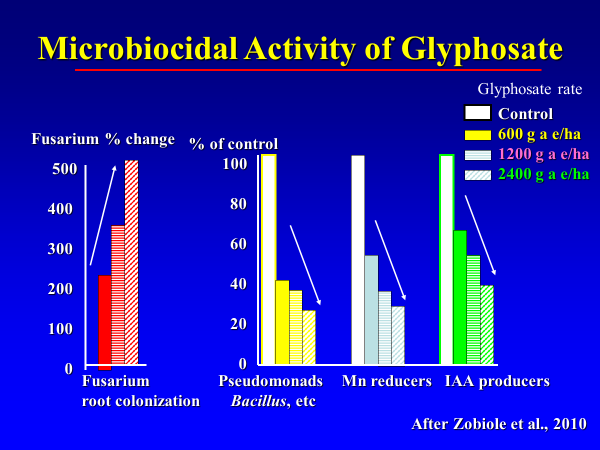One of the most common agricultural chemicals in use today is Glyphosate. It is commonly used for weed control and also crop “burn down” prior to planting the new crop. However, most people have no idea of how it actually works and what it does to the soils where it is used.
Glyphosate works by crippling a plant’s nutritional pathways and immune systems. To do so, it blocks the absorption of Manganese through a critical pathway. As a secondary affect, it also is a very efficient mineral chelator, thus tying up critical minerals in both the plant and the soil and reducing the nutrition to the plant
Once the plant is crippled, Glyphosate promotes the growth of soil-borne pathogens while effectively killing all the pathogen inhibiting beneficial microbes. The pathogens then attack the weakened and crippled plant which kills it.
There are four key points in this process that most farmers don’t understand, and don’t currently compensate for.


1. Glyphosate inhibits Manganese absorption, even in “roundup ready” plants.
Manganese is a critical mineral used by the plant in many functions and processes. It is critical in key nutrient absorption and utilization processes as well as photosynthesis, so a lack of manganese is extremely detrimental to the strength, growth, and development of the plant.
2. Glyphosate chelates (ties up) many nutrients, making them unavailable to the plant.
The glyphosate molecule has a very strong negative charge, so it very efficiently attracts and holds onto any available positively charged minerals. This reduces the mineral nutrition available for the plant, weakening the plant and making it more susceptible to disease and pests, even "round-up ready" varieties.
The lack of mineral nutrition can be especially challenging for plants when they are trying to set their yield. Plants determine yield based on the nutrients available to them. If the nutrients are tied up, there will be a significant decrease in yield because of it. For example, according to industry documentation, the recommended first application of ghlyphosate in corn is between V3 and V5. It is precisely during that time frame that the corn plant is determining how many kernels to produce around the circumference of the cob. Take away nutrition and the cobs will be smaller!
 3. Glyphosate is an extremely efficient anti-microbial product, targeting almost exclusively the beneficial microbes.
3. Glyphosate is an extremely efficient anti-microbial product, targeting almost exclusively the beneficial microbes.
The beneficial soil microbes are very sensitive to glyphosate, with extreme results at even very low concentrations (as low as .01 ppm). So applying glyphosate essentially wipes out your protective soil microorganisms, leaving it open to the proliferation of pathogenic organisms (disease).
4. Glyphosate stimulates the proliferation of pathogenic organisms
The affect goes far beyond lack of toxicity. Most pathogenic organisms are not sensitive to glyphosate and can easily withstand its application, even in higher concentrations. However, glyphosate actually excites and strengthens the pathogens, increasing their reproduction beyond the normal response to a lack of beneficial control.
Most farmers say, “But I have to do something about my weeds!”
There are other methods of dealing with unwanted growth, but they are longer term solutions, and they take some extra work too.
If you are determined to use glyphosate, then there are some tools and methodologies you can use to minimize the negative effects.
- Use Argosy RF which greatly increases the effectiveness of the glyphosate while requiring much less of it and fewer applications, thus reducing some of the secondary negative effects.
- Always apply glyphosate with Glyphonix to block the mineral chelation effect and allow uninterrupted nutrient flow to the plant.
- If you use glypohosate for burn-down before planting the next crop, don’t plant immediately. Wait 10-14 days before planting for better results (and always apply microbiological boosters when planting to replace what the glyphosate killed).
- Always follow glyphosate application with foliar trace mineral supplements, especially manganese. Apply the foliar supplements 7-10 days after the glyphosate application.
- Always follow glyphosate application with microbiological supplements and stimulation. Apply microbiology 7-10 days after the glyphosate application.
- By following these recommendations, you can minimize your short-term glyphosate usage and compensate for the negative effects while working toward better and longer-term solutions which will keep your soils and your plants healthy and functional. Healthier soils produce healthier plants which have less disease and better yields, providing better results for you and your farm.

